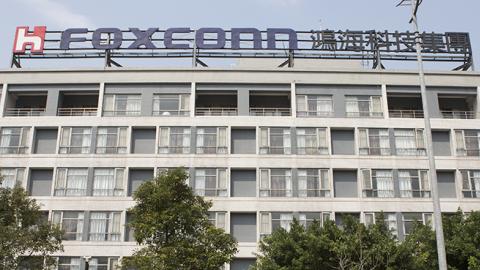Wisconsin Gov. Scott Walker in September announced a $3 billion tax incentive for Foxconn, the Taiwanese technology behemoth. The deal makes Foxconn the largest foreign recipient of U.S. state-level subsidies in the country. Gov. Walker has promised that Foxconn will add 13,000 new jobs to the state, many of them through a flat-screen television factory with an area equal to eleven football fields. Foxconn is the world’s largest contract electronics manufacturing company. With its 1.3 million global employees and $136 billion revenue, Foxconn is also the world’s fourth-largest information technology company. Foxconn produces products including the iPhone, iPad, iPod, Blackberry, and Kindle, as well as the Playstation and Xbox entertainment consoles.
Foxconn’s size makes it a critical aspect of the broader economic relationship between the United States and Taiwan. Fifty years ago, Taiwan was a net recipient of U.S. economic and food assistance, in addition to American military support. Today, with $65 billion in total trade, Taiwan is the United States’ tenth-largest trading partner. In the Pacific, it sits behind only China, Japan, and South Korea. India only surpasses Taiwan by $2 billion in trade volumes with the United States even though Taiwan’s population is 1.7 percent that of India. As of 2016, Taiwan serves as the United States’ 13th-largest import supplier and 14th-largest export market. Such volumes belie Taiwan’s geographic and demographic size – it has a population of 23 million and covers a territory only slightly larger than Maryland.
Creating the tiger
Sound economic policy and progressive liberalization transformed Taiwan into one of Asia’s tiger economies. When the Kuomintang nationalist government relocated to Taiwan in 1949, the island was relatively undeveloped. The new Republic of China had the advantage of gold reserves from the mainland and intellectual capital provided by dissidents who fled Mao’s Communist regime. Still, the economy was relatively agrarian, and the island lacked critical infrastructure. Easy lines of American credit, food aid, and $4 billion in financial instruments allowed the ROC to develop its economy from 1945 to 1965. Import-substitute industrialization created a localized economy protected from international competition by high trade barriers. This state of affairs persisted until the 1970s. Government intervention and tariffs defined the Taiwanese economy, and exports were labor-intensive. Taiwan’s economic profile resembled Vietnam, the Philippines, and mainland China today.
Geopolitics dictated a shift in economic policy. Nixon and Kissinger’s opening to China ultimately resulted in Taiwan’s removal from the United Nations and loss of formal diplomatic contact with the majority of the international community. The Taiwanese government responded by encouraging modernization in all industries, specifically focusing on personal computing and electronics production. This enabled Taiwanese firms to become suppliers to big Western companies like IBM. Increased prosperity enabled further modernization and combined with Taiwan’s educational system to increase the workforce’s skill level. As wages rose, Taiwanese companies shifted production off the island to lower-skill areas like mainland China. The internationalization of supply chains reinforced this process while encouraging Taiwanese trade and catalyzing a decline in trade barriers. Taiwan’s “economic miracle” had political ramifications – independent unions and increased capital flows eroded the central government’s political control, paving the way for Taiwan’s future democratization. Today’s per capita gross national product offers a stark contrast to Taiwan’s past. In 1952, Taiwan’s GNP per capita totaled one-thirtieth that of the United States. Modern Taiwan’s GNP per capita of $35,277, adjusted for purchasing power parity, is similar to Western Europe’s and Japan’s.
Productive engagement
In fewer than 50 years, Taiwan has been transformed from an industrial, one-party state into a thriving liberal democracy. This occurred in large measure because of Taiwan’s engagement with the international economic system. Taiwan today has one of the world’s highest trade-to-GDP ratios. It is party to the World Trade Organization and has signed trade agreements with five Latin American countries plus Singapore and New Zealand. Its only remaining trade barriers are against products from mainland China, and even those are diminishing under WTO mechanisms. As political trends on the left and the right indicate resistance to economic liberalism and international trade, Taiwan demonstrates the fundamental soundness of economic policy based upon broadly liberal principles. These principles would be a guide for Taiwan’s economic policy were a broad trade agreement among Pacific states reached.
Notwithstanding, U.S. President Donald Trump has decided to eliminate the Trans-Pacific Partnership. The proposed agreement was imperfect, complex, and subject to political critiques at key points. But its failures do not diminish the efficacy of, and the need for, a comprehensive Pacific trade policy that encourages growth among free nations on both sides of the Pacific.
Economic competition typically serves as a prelude to political confrontation. Otto von Bismarck’s Prussia solidified its European position through two bloody wars, but the Iron Chancellor manipulated pre-existing economic conditions to catapult his kingdom to German dominance. The Zollverein, a German customs union that included Austria, Prussia, and the central German states, inexorably drew the German Confederation into Berlin’s orbit. Bismarck used this underlying shift in economic power to confront Austria, gaining mastery of Central Europe.
China’s championing of economic institutions including the One Belt One Road initiative, the Beijing-based Asia Infrastructure Investment Bank, and the New Development Bank, headquartered in Shanghai, indicate a similar strategy at work. If China succeeds in eroding economic links between the United States and its Asian partners, including South Korea, Japan, the Philippines, and Singapore, it will have taken a giant step toward ejecting the United States from the Western Pacific. In a Chinese-dominated Asia, China would account for 60 percent of economic output. This dominance would serve as a springboard for further economic—and ultimately, military—power projection.
The Foxconn deal could serve as a model for future American economic engagement in Asia. If multi-party trade agreements like the TPP are unreachable, direct free trade links with specific states and companies should serve as the core of the United States’ economic efforts. Engagement with Taiwan is a critical aspect of these efforts. Its robust democratic institutions, liberal economic outlook, and strategic position qualify it as a leading candidate for increased U.S. engagement. The Trump administration will advance its goal of providing more jobs as it increases security in the West Pacific by reaching a bilateral trade agreement with Taiwan.

















